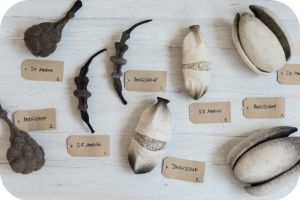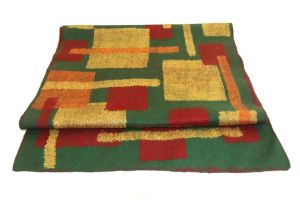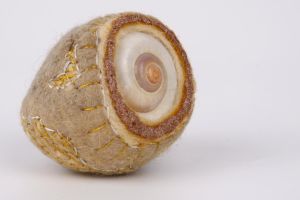
Wool has a complex of characteristics that characterize its physical and technological properties. The main physical and mechanical properties include length, thickness, crimp, strength, extensibility, color, gloss, elasticity, elasticity and plasticity. Spinning and hardiness are technological properties. They are extensively covered in the special literature, so we will dwell briefly only on some of them.
Thinness / thickness. One of the most important signs of wool is its toning. By the thickness of the wool is meant the diameter of the cross section of the wool. Tonin expressed in thousandths of a millimeter - micrometers (microns). The ton of wool depends on the breed, the conditions of feeding and maintenance, the sex of the animals, their age and individual characteristics. In young animals, wool is thinner than in adult sheep. With age, the coat coarsens, and after 5-6 years of age, due to the weakening of the vital functions of the body, the wool becomes thinner. In queens, the wool is thinner than that of the rams. The most fine wool is obtained from sheep fine-fleece (25 microns and thinner). Sheep of semi-fine-ruffled breeds give a wool of fineness 25.1 microns and coarser. Such wool can also be given by fine-coarse-coarse crossbreeds. The wool of sheep semi-coarse-wool and coarse-wooled breeds is mostly heterogeneous. Depending on the tint of homogeneous wool in our country is divided into the following classes of tonic:
Classify the four main groups of sources of production of wool: sheep, goats, camels, rabbit fluff. Characteristics of some types of wool are given in the table:

In production conditions, the wool fineness is determined organically-leptically, for which 3-5 staples are taken from different parts of the fleece. Each one is alternately taken with the thumb and forefinger of both hands by the ends, spread until the mesh is formed and viewed to determine the fineness of the fibers, the equalization of the fineness over the zones of the staple. In determining the class, the tones of homogeneous wool sometimes (with disagreements, etc.) use reference samples of wool. For more accurate determination of wool fineness, a laboratory method is used in which the diameter of the cross section of a wool fiber is determined under a microscope or a linearimeter and expressed in micrometers.
Thin-wool wool consists of downy fibers, having a ton of no more than 25 microns (not rougher than the 60th grade). The length of the wool in the staple is 7-9 cm. The fine wool is divided into merino and non-merino wool by qualitative indicators.
Merino wool - white, soft, elastic, well-balanced in tonic and length, contains a sufficient amount of fat.
Neremenosovaya wool from merinovoj differs insufficient balancing of wool fibers on tonic and the length, less crimp.
The length of the coat is the most important property that determines its production purpose, one of the main breeding features. The length indicator is especially important for fine and semi-fine wool. Distinguish the natural length of the hair in a twisted state, the natural length in a stretchable, but not stretched form. For natural length, the height of a staple or a braid with natural twisting or waviness of the wool is assumed. It is measured with a ruler accurate to 5 mm. Two dimensions are defined in the scythe-the length of the awn and the length of the downy tier. These measurements are recorded with a fraction: in the numerator - the total length of the braid (awn), in the denominator - the length of the downy tier.
The true length is the length of the wool fibers in the straightened, but unstretched condition. It is measured to within 1 mm. To determine the true length, use 4-10-2-2a devices (for fibers up to 200 mm in length) and 4-10-1-26 (for fibers up to 350 mm in length). The longest wool of long-haired beef sheep (Lincoln, etc.) and some coarse-wooled (Mining Carpathian, etc.) breeds up to 40 cm and more; short - for fine wool and some coarse-wool (gissar, etc.) - 4-7 cm.
The length, as well as the tone of the coat, depends on a number of factors, the main of which are the pedigree and individual characteristics of sheep, the conditions for their feeding and maintenance, the physiological condition. The length of the wool depends on the breed, sex and age of the sheep, the level of their feeding, and other factors. The shortest wool has sheep fine-wool breeds (6-9 cm). Sheep and stags produce a longer coat than the uterus. In young animals up to the year-old age, the hair grows faster than in adult sheep; for 4-5 years, the increase in wool over the year is approximately the same, and after 5-6 years of age, the growth rate of wool is slowed down. With a low level of feeding, hair growth slows down, the fiber becomes thinner, its strength decreases. The length of the coat on different parts of the animal's body is different: on the shoulder blades, sides, thighs, it is longer than on the belly, back.
Fortress of wool. Under the strength of wool is meant the resistance of wool fibers to tearing. Strength depends on the stability of the fibers in the primary processing, as well as the wear and duration of the use of the product. Strength of fibers on the gap is expressed in absolute and relative terms. Absolute strength is characterized by effort, under which the fiber is torn; relative - the magnitude of the breaking force per unit area of the cross section of the hair. The constitution of the animal, the physiological state and individual characteristics of the organism, the conditions of feeding and maintenance have a great influence on the strength of the wool.
Crimped wool. The crimp of woolen fibers is characteristic of sheep's wool, it has a certain connection with the thickness of the fibers. Crimp is a very valuable feature of wool, which increases its elastic properties. Twists of different size and shape are characteristic of fine and semi-fine wool. Crimp is a breed sign associated with the constitution of sheep, fiber density, fat content and other indicators. The nature of the tortuosity is determined by the ratio of the ortho- and p-cortex. The crimp is characteristic of all types of wool fibers, except for the covering hair. Crimp promotes the protection of the fleece from ingress of mechanical impurities and atmospheric precipitation. It is taken into account when the sheep are bonitized and the wool is classed. In the thin and semi-fine wool distinguish three basic forms of twists: normal, flat and high. If the curls are close in shape to the semicircle, they are called normal, which is typical for wool fine-fleeced sheep. In flat curves, the height of the arc is smaller than its base. Osty often has a weak crimp, fluff of homogeneous wool - normal, transient hair of homogeneous wool - flat. The pronounced crimp correlates with the increase in the cortical layer of the share of the parasegment and the content of sulfur.
The plasticity of the wool is the ability of the fiber to receive and retain the accepted shape after the cessation of the effect that caused the change in shape. Fibers with the highest plasticity are characterized by a high specific gravity of the amorphous part / gamma-keratose / and the content of tyrosine.
Color of wool. The color of the coat is determined by the presence in the cortical layer of the pigment melanin, contained throughout the entire length or in part of the fiber. The basic colors of the coat are white, black and red. In industrial production, white is highly valued, which is more in line with the requirements of the processing industry, since only white wool can be painted in any color. The color of the coat depends on the content of the pigment melanin in the cortical layer. Coarse-wooled sheep have a different color - black, red, gray.
Spinning ability and wooliness of wool. These properties do not have externally expressed characteristics, but are the cumulative result of all physical and mechanical properties of fibers and are valued during processing as the main merits of wool raw materials. The spinning capacity is expressed by the number of yarn / ratio of the length of the yarn to the weight of the wool used. The individual physical properties of the wool have different effects on the spinning process.
Width - the ability of fibers under certain conditions, humidity and temperature to strongly intertwine and adhere, forming a dense mass - dumps. The grossness of the coat is due to the structure of the scaly fiber layer, its elastic-elastic properties and crimp. It is proved that the predisposition of wool to profusion is a hereditary sign.
Fat. Fleece sheep, contains a fat - a product of the secretory activity of the sebaceous and sweat glands. Sebaceous glands produce fat / wax /, which includes mixtures of esters of primary and secondary alcohols, free high molecular weight alcohols, as well as free high molecular weight and in a small amount low molecular weight fatty acids. Alcohols of wool fat consist of aliphatic monoalcohols and alkane-1,2-diols of normal, as well as iso-and anti-isostructural. The main of them are cholesterol esters, which account for about 40%, lanosterol and another three C30 alcohols, which, like lanosterol, are 4,4,14-a-trimethylsterols. In addition, a small amount of cerebrosterol and 25-yhicholesterol is observed in wool fat. The latter is formed as a result of self-oxidation.
The fatty acid composition of the wax, according to our data, is represented by 31 acids with an even and odd number of carbon atoms, as well as iso-acids. The main ones are considered to be cerotinic and lignoceric, which make up about 50% of the amount of all acids. It is important to recall that wool fat does not contain glycerol / triacylglycerol esters, which are known to be a constituent of any fat.
The secretion of sweat glands is a hygroscopic mixture of salts of inorganic / hydrochloric, sulfuric, phosphoric / and organic / lactic, oily / acids, potassium salts of oleic and stearic acids, carbonates, chlorides, phosphates and sulfates of calcium, sodium, magnesium, iron, aluminum, and also a small amount of nitrogenous substances. According to Z.V. Kalinina (1976), the main components of sweat are the compounds of alkali metals, primarily potassium and to a lesser extent sodium. The greatest specific weight of compounds of calcium, phosphorus, sulfur and iron.
Among all components of fat, only wool fat plays an important role in preserving the physical properties of wool. Covering a thin layer of fiber, it promotes their gluing, forming staples and braids, and as a whole - dense fleece. In addition, it protects the wool from ingress of mechanical, mineral and vegetable impurities, and also protects the fiber from the harmful effects of solar radiation and atmospheric precipitation. The amount of wool is a very variable indicator, depending on the pedigree of the animals, their individual and sex-age characteristics, the nature of feeding, the conditions of detention, etc. The quality of the wool largely depends on the protective properties of the wax.


So, the wool has a whole complex of characteristics, characterizing its physical, and, consequently, technological properties. The question naturally arises: Does the relationship between structure, chemical composition and physical properties of wool exist and to what extent? At present, a very limited number of works are devoted to this question. The available information still indicates a correlation between plasticity and segmentation of the cortical layer of fine wool, between the degree of cortex asymmetry and the fecundity. A direct correlation is established between the quantity and quality of the fat, yellowing and wooliness. Specific strength, full elongation and extensibility of wool fibers are in a straight line depending on the ratio of keratoses in them, i.e. structure of wool. Studies have shown the existence of a relationship between the sulfur content in the wool fiber and its strength. As the content of sulfur, and hence cystine in the wool increases, its strength increases.
Now in theory you are a professor, it's time to move on to practice...













